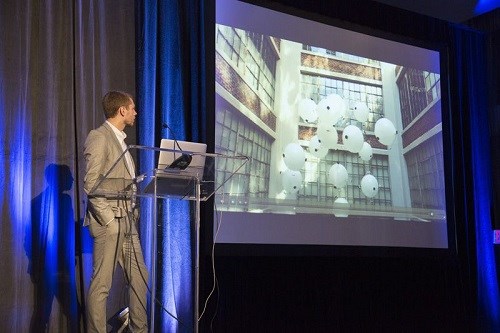The Promise of "4D Printing"
MIT scientist is shaping the next development to 3D printing: 4D printing, where the fourth dimension is time.

In terms of the “wow factor” at the recent GPS2015, co-hosted byand, I’d say the starring role perhaps belonged to Skylar Tibbits who was the innovation keynote speaker of the session “Glimpse into the Future: The Next Generation of Plastics.”
Director/research scientist of the at MIT’s Dept. of Architecture, Tibbits has been leading a unique research collaboration between MIT and the education and R&D departments of , which promises to shape the next development to 3D printing. Coined and popularized by Tibbits with numerous TED Talks over the last five years, 4D printing--whereby the fourth dimension is time—refers to his group’s research that promises to revolutionize material form and control. It will allow the printing of items that adjust themselves and self-assemble over time in order to accommodate changing physical conditions, or to repair themselves. As such, it has the potential to have an enormous impact on a host of different market sectors-- from healthcare, to construction and infrastructure, to aerospace and automotive, to packaging and consumer products.
Stratasys’ Objet Connex multi-material 3D printing technology has been an important part of Tibbits’s 4D research. With Connex technology, a single print with multi-material features can transform from any 1D strand into 3D shape, 2D surface into 3D shape or morph from one 3D shape into another. Researchers can program different material properties into each of the various particles of the designed geometry and harness the different water-absorbing properties of the material to activate the self-assembly process.
With water as its activation energy, this technique promises new possibilities for embedding programmable and simple decision making into non-electronic based materials. Imagine robotics-like behavior, says Tibbits, but without the reliance on complex electromechanical devices. “Self-assembly is a process by which disordered parts (no humans, no machines) can assemble themselves—random energy produces non-random results.”
Tibbits says they have aimed to form new programmable, reconfigurable materials—strands, sheet, extrusions—and activate them to change—mechanically transform. “We’re trying to demonstrate that any fundamental material—including varying kinds of plastics, carbon fibers, textiles, wood, glass--can be a smart material.” He says nearly every material can be programmed to promote forming, curling or, as the researchers say, self-morphing.
Tibbits gave a recent ‘morphing’ example of the latest rendition of the BAC Mono super car—by England’s Briggs Automotive Company (BAC)..a car that provides a glimpse into the future of custom automotive manufacturing. “They wanted to morph a rear wing of the vehicle to allow for an autonomous way to control air flow. This was accomplished by 3D printing a single sheet of carbon fiber with polymers that promote moisture—essentially, the component is activated by responding to rain.”
In addition to automotive, aerospace (his group is currently working with Airbus), and self-forming large architectural structures, he also sees lots of scenarios for new packaging with this highly-advanced technology—smart, active packaging that can self-form and would support recyclability/sustainability, such as using agitation to assemble and methods to dissolve for disposal. Similarly, he sees this technology being used to make various self-forming consumer products. Imagine having a pair of shoes that actively change to fit the environment!
Now a ripe 30-yr old, Skyler Tibbits was awarded a TED2012 Senior Fellowship, a TED 2011 Fellowship, and was named a Revolutionary Mind in SEED Magazine’s 2008 Design issue.
Related Content
Evonik Publishes Life Cycle Assessment Data in High Performance Polymers Plastics Database
Highlighted is data on the more than 100 grades of the company’s Vestamid nylons and Trogamid transparents.
Read MoreHow to Optimize Injection Molding of PHA and PHA/PLA Blends
Here are processing guidelines aimed at both getting the PHA resin into the process without degrading it, and reducing residence time at melt temperatures.
Read MoreHigh-Jetness Carbon Black for Engineered Plastics
Orion’s new Printex chroma 500 Beads are well suited for applications such as injection molded automotive parts and household appliances.
Read MorePOGS Chooses Novodur ECO ABS for Childrens Headphones
Manufacturer of audio equipment for children will use INEOS Styrolution ABS with 50% recycled content.
Read MoreRead Next
Beyond Prototypes: 8 Ways the Plastics Industry Is Using 3D Printing
Plastics processors are finding applications for 3D printing around the plant and across the supply chain. Here are 8 examples to look for at NPE2024.
Read MoreMaking the Circular Economy a Reality
Driven by brand owner demands and new worldwide legislation, the entire supply chain is working toward the shift to circularity, with some evidence the circular economy has already begun.
Read MoreLead the Conversation, Change the Conversation
Coverage of single-use plastics can be both misleading and demoralizing. Here are 10 tips for changing the perception of the plastics industry at your company and in your community.
Read More














